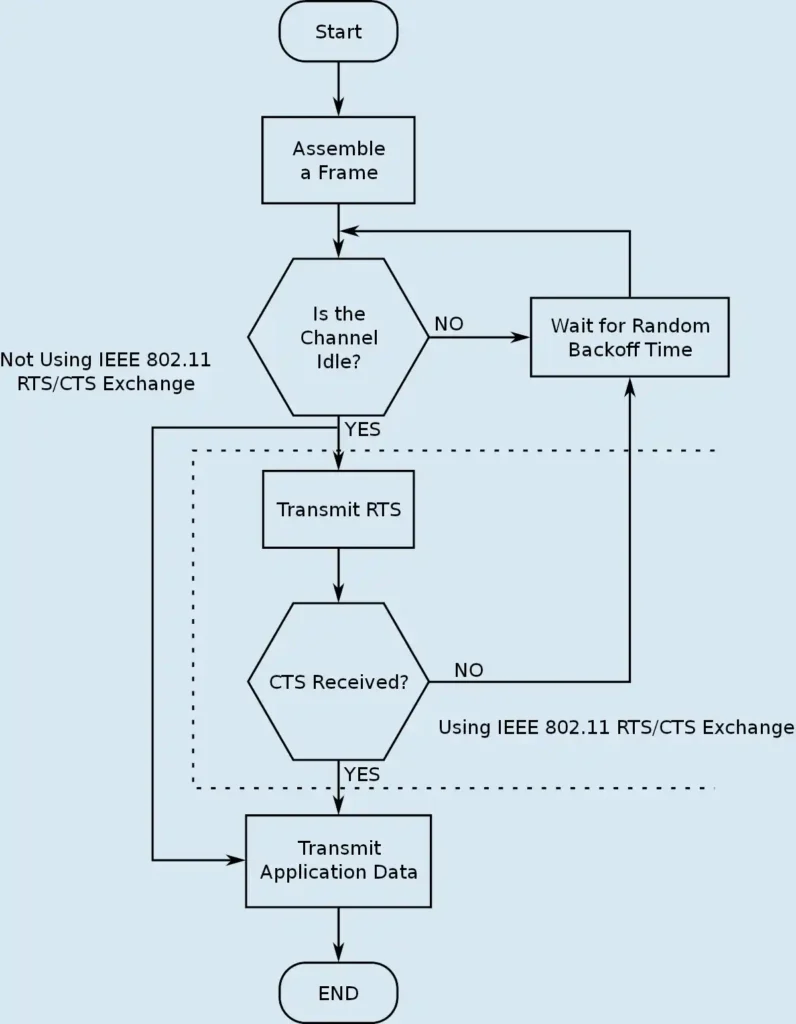In the intricate tapestry of network communication, Carrier Sense Multiple Access with Collision Avoidance (CSMA/CA) emerges as a pivotal media access control method, especially critical in the realm of baseband transmission networks. Predominantly utilized in wireless networking, CSMA/CA is engineered to adeptly manage network traffic by skillfully preventing data collisions. This intelligent approach to network communication ensures smoother data transmission and enhanced network efficiency. By mitigating the risks of data packet collision, CSMA/CA plays a key role in maintaining the integrity and reliability of wireless networks.
This article is poised to delve deep into the operational intricacies of CSMA/CA, exploring its mechanisms, comparing it with other methods, and unraveling its profound implications in contemporary network communication.
Table of Contents:
- Understanding CSMA/CA
- Mechanics of CSMA/CA
- CSMA/CA in Wireless Networks
- Comparative Analysis: CSMA/CA vs. CSMA/CD
- Future of CSMA/CA
- References

1. Understanding CSMA/CA
Concept and Operation
CSMA/CA is a method designed to reduce the chances of collision in a network by preemptively sensing and avoiding potential data packet conflicts during transmission.
- Listening Before Transmitting: In CSMA/CA, a station (or network device) first listens to the network media to determine if another transmission is occurring. If the medium is clear, the station will then announce its intention to transmit before sending data, effectively signaling other stations to withhold their transmissions.
- Collision Avoidance: Unlike methods that detect and manage collisions post-occurrence, CSMA/CA proactively works to avoid collisions altogether. It employs an algorithm to wait for a random period if the medium is busy, reducing the likelihood of simultaneous transmissions.
Differentiation from Other Methods
CSMA/CA stands apart from other network access methods, particularly its counterpart, CSMA/CD (Collision Detection), which is prevalent in wired networks like Ethernet.
- CSMA/CA vs. CSMA/CD: While CSMA/CD listens to the network and sends data, only stopping if a collision is detected, CSMA/CA takes a more cautious approach by actively trying to prevent collisions before they happen. This distinction is crucial in wireless networks where detecting collisions is more challenging due to the nature of wireless communication.
- Suitability for Wireless Networks: The preemptive nature of CSMA/CA makes it particularly well-suited for wireless networks like Wi-Fi. In these environments, the physical medium (air) does not allow for easy detection of collisions, necessitating a method that focuses on avoidance rather than detection and recovery.
In summary, Carrier Sense Multiple Access with Collision Avoidance represents a sophisticated approach to network access in wireless environments, characterized by its proactive measures to ensure seamless and collision-free data transmission. Its contrast with methods like CSMA/CD highlights the unique challenges and solutions in different network setups, particularly underscoring the nuances of wireless versus wired networking.
2. Mechanics of CSMA/CA
Technical Workings of CSMA/CA
CSMA/CA operates on a set of procedural steps to manage data transmission in a network, particularly in environments where collision detection is not feasible.
- Listening Phase: Before initiating a transmission, a station listens to the network to ascertain if the channel is free. This ‘listening’ or sensing is crucial to determine whether another station is transmitting data.
- Announcing Transmission Intentions: If the medium is found to be idle, the station waits for a predefined period, known as the Distributed Inter-Frame Space (DIFS), and then broadcasts an intent to transmit. This broadcast alerts other stations to refrain from sending data, thus minimizing the chances of collision.
- Collision Avoidance Strategy: The station checks the medium again post-DIFS to ensure it is still free before proceeding with data transmission.

The Backoff Algorithm
- Functionality: In scenarios where the medium is busy, Carrier Sense Multiple Access with Collision Avoidance employs a backoff algorithm. This algorithm instructs the station to wait for a random period before attempting to listen and transmit again.
- Randomness and Efficiency: The randomness in the backoff period helps in evenly distributing the chances of transmission among multiple stations, thereby reducing the probability of repeated collisions.
3. CSMA/CA in Wireless Networks
Application in Wi-Fi
CSMA/CA is particularly integral to the functioning of Wi-Fi networks, where it orchestrates the orderly transmission of data packets.
- Wi-Fi Data Transmission: In Wi-Fi, CSMA/CA is the standard approach to handle multiple devices trying to access the network simultaneously. It ensures that devices communicate efficiently without overloading the shared wireless medium.
- Adaptability: The flexibility of CSMA/CA allows it to adapt to varying Wi-Fi network sizes and densities, from small home networks to larger, more congested public Wi-Fi hotspots.
Challenges in Wireless Environments
Wireless networks face unique challenges that CSMA/CA helps to mitigate.
- Hidden Node Problem: In wireless networks, not all stations may be within the range of each other, leading to the ‘hidden node problem,’ where a station might not hear another station’s transmission, increasing the risk of collision. CSMA/CA, with its emphasis on collision avoidance, helps in reducing such scenarios.
- Signal Interference: Wireless networks are susceptible to interference from various sources, like other electronic devices or physical obstructions. CSMA/CA’s proactive listening and waiting mechanisms help in mitigating the adverse effects of interference on network performance.
In conclusion, the mechanics of Carrier Sense Multiple Access with Collision Avoidance showcase a sophisticated and well-structured approach to managing data transmission in networks where collision detection is not viable, particularly in wireless settings like Wi-Fi. The protocol’s ability to address the unique challenges of wireless environments underlines its importance in modern network communication infrastructures.
4. Comparative Analysis: CSMA/CA vs. CSMA/CD
Side-by-Side Comparison
Understanding the differences between CSMA/CA and CSMA/CD is essential for grasping their respective roles in network communication.
- CSMA/CA (Collision Avoidance):
- Used in: Predominantly in wireless networks like Wi-Fi.
- Method: Actively tries to prevent collisions by ‘listening’ before transmitting and using a backoff algorithm when the channel is busy.
- Advantages: More effective in environments where collision detection is challenging; reduces the likelihood of collision.
- Disadvantages: Increased overhead due to the need for acknowledgment packets; can be slower due to the waiting time introduced by the backoff algorithm.
- CSMA/CD (Collision Detection):
- Used in: Primarily in wired networks, notably Ethernet.
- Method: Detects collisions when they occur and then attempts retransmission after a random time delay.
- Advantages: Efficient in environments where collisions can be easily detected; typically faster as it transmits without waiting.
- Disadvantages: Not suitable for wireless networks due to difficulty in detecting collisions; less efficient in high-traffic environments.
5. Future of CSMA/CA
Emerging Trends and Advancements
The future of CSMA/CA is intertwined with advancements in wireless technology and the increasing demand for efficient network communication.
- Integration with Advanced Wireless Standards: As wireless standards evolve (e.g., Wi-Fi 6), Carrier Sense Multiple Access with Collision Avoidance may see enhancements to better accommodate higher throughput and more connected devices.
- Adaptation to IoT Environments: With the proliferation of IoT devices, CSMA/CA might be adapted to manage the dense and diverse nature of IoT networks more effectively.
Impact on Evolving Network Technologies
- Support for Increasing Bandwidth Demands: Future iterations of CSMA/CA will need to address the growing bandwidth requirements of modern network applications.
- Enhanced Efficiency in Dense Networks: Ongoing research is likely to focus on improving the efficiency of CSMA/CA in environments with a high density of devices, which is a common scenario in urban and industrial areas.
6. References
- Technical Documents and Research Papers:
- “Carrier Sense Multiple Access with Collision Avoidance (CSMA/CA) in Wireless Local Area Networks,” IEEE Wireless Communications.
- “Understanding Wireless Communications in Public Safety,” Kathy J. Imel and James W. Hart.
- Relevant IEEE Standards and RFCs:
- IEEE 802.11 Standards: Define the set of media access control (MAC) and physical layer (PHY) protocols for implementing wireless local area network (WLAN) computer communication.
- RFC 4944: Transmission of IPv6 Packets over IEEE 802.15.4 Networks, pertinent to understanding the application of CSMA/CA in low-rate wireless personal area networks.